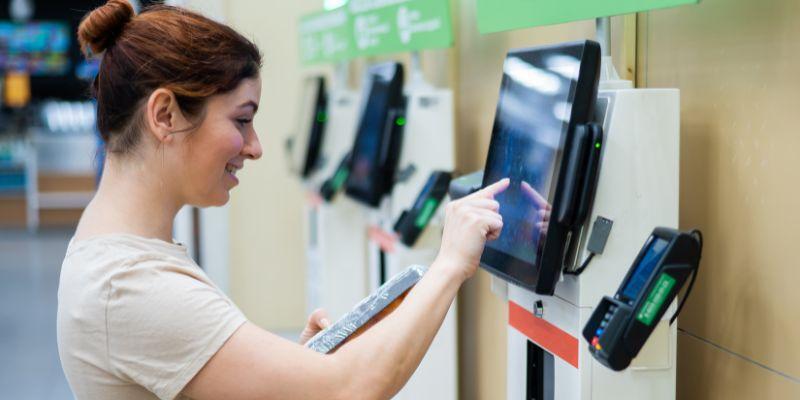Looking into business dynamics, one realizes that self-customer service is necessary for modern businesses.
It lets customers solve problems independently without needing help from a customer service agent. With technology and digital tools, people want quick and easy ways to get things done.
Businesses can use online portals and kiosks to help customers faster and save time and resources. Self-service is all about giving customers control and making things simpler.
This article explores why self-service matters, gives examples, and explains the benefits. It also offers easy tips for businesses to use self-service effectively. By reading this, you’ll see how self-customer service can make a big difference, keeping customers happy and businesses successful.
What Is Self-Service?
Self-service is when customers can handle tasks independently without needing the staff’s help. It’s like using a machine at the store instead of asking someone for assistance. This type of customer experience is called customer-self service experience.
Self-service options make things quicker and simpler for customers, whether checking out at a grocery store or using an ATM to withdraw cash.
It’s all about giving people the power to help themselves with their questions or needs, making their interactions with a business more efficient and convenient. This trend is known as self-service customer service and is becoming more common today.
What Is Self-Service Experience?
Self-service experience refers to an individual’s perception of an organization based on a series of self-service interactions. This opinion is shaped over time through multiple interactions with the brand.
Self-service allows customers to solve their problems, reducing reliance on customer service representatives. In the digital age, self-service channels transform service organizations by providing always-available solutions.
The customer support portal plays a central role, offering low-effort options. Successful self-service strategies require understanding customer behavior and preferences.
Advantages of Self-Customer Service

Self-customer service offers numerous advantages that transform how businesses interact with their clientele.
Businesses can increase efficiency, satisfaction, and overall success by allowing customers to take control of their inquiries and transactions. Let’s explore the key benefits of self-customer service in detail.
1. Convenience for Customers
Customer self-service makes things easier for you. Instead of waiting in long lines or being on hold for long, you can use self-service options like apps or websites to get things done quickly.
It’s like doing things yourself, but online. Customers can buy stuff, check their accounts, or get help without leaving their houses!
2. Cost-Effectiveness for Businesses
Businesses save money when customers use self-service options. Instead of having many people answering phones or helping in stores, they can use self-service marketing solutions.
This means they spend less money on paying employees, which can help them offer better prices or improve their services through marketing efforts directed via self-service.
3. Increased Efficiency and Scalability
Self-service options help businesses run more smoothly. When customers use a self-service option, like a website or an app, you help businesses handle many customers without needing extra staff. This means they can help more people without things getting slow or messy.
4. Empowerment of Customers to Resolve Issues Independently
When a patron uses client self-service, they are in control. They can solve problems or get information without waiting for someone else to help them. It’s like being their boss! Self-service options allow them to do things on their terms whenever necessary.
5 Examples of Self-Customer Service

Transform your business with self-customer service solutions, exemplified by online FAQs and automated chatbots. These tools enable customers to find quick resolutions independently, reducing support costs and enhancing satisfaction.
Let’s explore how industry leaders leverage self-service options to optimize operations and boost customer loyalty.
1. Automated Customer Support Systems
Automated customer support systems or self-customer care employ artificial intelligence and chatbots to provide instant assistance around the clock.
Handling common queries and issues without human intervention ensures customers receive timely support, improving satisfaction, recording customer feedback, and reducing wait times.
2. Self-Help Portals and Knowledge Bases
Self-help portals and knowledge bases are centralized hubs of customer information and solutions. Accessible online, they allow users to troubleshoot problems independently, offering detailed guides and FAQs to address various inquiries.
3. Mobile Applications for Customer Support
Mobile apps dedicated to customer support offer a convenient way for users to seek smartphone assistance.
With features like real-time chat, ticket submission, and access to account information, these apps enable customers to resolve issues on the go, improving accessibility and user experience.
4. Self-Service Kiosks
Self-service kiosks, including cash deposit machines (CDMs), provide customers with a user-friendly interface to perform transactions and access services independently.
Whether depositing cash, printing tickets, or checking in for appointments, these kiosks simplify processes, reduce queues, and boost efficiency.
Understanding the benefits of self-service kiosks can further enhance customer satisfaction and operational effectiveness.
5. Digital Customer Service Platforms
Digital customer service platforms integrate various self-customer service tools into a unified system, offering users a uniform experience.
From virtual assistants to online chat support and knowledge bases, these platforms cater to diverse customer needs, improving accessibility and satisfaction.
4 Best Practices for Implementing Self-Customer Service

Implementing self-customer service effectively requires adherence to best practices to ensure optimal outcomes.
Following these guidelines, businesses can reorganize daily operations, increase customer satisfaction, and drive growth. Let’s explore some key strategies for implementing self-customer service:
1. User-Friendly Interface Design
Creating a user-friendly interface design is vital when implementing self-customer service solutions. A user-friendly interface ensures customers can access the self-service platform quickly, improving their overall experience.
To achieve this, businesses should align the interface design with the established customer self-service definition, ensuring consistency and clarity in functionality.
This involves organizing information logically, employing intuitive navigation menus, and incorporating visual cues to guide users through the self-service journey.
Additionally, the interface should feature clear instructions and prompts to assist users in completing tasks effectively. Businesses can maximize customer engagement and satisfaction with their self-service offerings by prioritizing simplicity and ease of use in interface design.
2. Regular Updates and Maintenance
Regular updates and maintenance are crucial for ensuring the smooth functioning of customer self-service solutions. By updating the system regularly and performing maintenance checks, businesses can address any potential issues promptly, preventing disruptions to the self-service experience.
This involves regularly reviewing and optimizing the self-service platform in line with the customer self-service definition to ensure it remains relevant and practical.
Additionally, updating the platform enables businesses to incorporate new features and enhancements based on customer feedback and evolving needs.
Maintenance tasks may include software updates, security patches, and hardware maintenance to keep the self-service infrastructure running efficiently. By prioritizing regular updates and maintenance, businesses can uphold the reliability and performance of their self-service solutions.
3. Integration with Other Customer Service Channels
Integration with other customer service channels is essential for providing a uniform experience across all touchpoints.
When aligning self-customer service solutions with existing channels such as phone support, email assistance, and live chat, businesses can offer customers a consistent experience regardless of their chosen channel.
This integration ensures that customer interactions are tracked and managed efficiently, allowing for a unified view of customer history and preferences.
Moreover, it enables businesses to leverage insights via business analytics from various channels to improve the overall quality of service and effectively address customer needs.
4. Providing Alternative Support Options
Offering alternative support options is crucial for accommodating varied customer needs under self-customer service. Besides traditional channels like phone and email, businesses can provide self-service options like FAQs, knowledge bases, and chatbots.
These alternatives enable customers to find solutions independently, reducing dependency on direct assistance. Additionally, self-service options cater to varying preferences and time constraints, ensuring flexibility for customers to seek help anytime, anywhere.
Case Studies
1. Revolutionizing Customer Self-Service: Wavetec’s Solution for Emirates Airlines
Wavetec’s comprehensive queue management and self-service solutions have transformed Emirates Airlines’ customer service operations across 71 global stations. The customized system aligns customer flow, reduces waiting times, and increases overall involvement.
With intelligent kiosks and digital signage, Emirates staff can efficiently serve customers based on priority, improving service quality and operational efficiency.
The central reporting software enables Emirates’ headquarters to monitor branch performance and employee productivity in real time, ensuring consistent service standards worldwide.
2. Transforming Telecom Convenience: Wavetec’s Self-Customer Service Kiosks at Union Station Toronto
Wavetec’s cutting-edge self-customer service kiosks at Union Station, Toronto, revolutionize telecom convenience. Partnering with EZ Sim, these kiosks offer instant SIM card issuance and airtime purchases, allowing commuters with seamless self-service solutions.
When facilitating self-customer service, Wavetec increased customer convenience and furthered Chatr Mobile’s brand awareness as a forward-thinking leader in the digital era.
Final Words
In conclusion, self-customer service is a fundamental aspect of modern business operations. It revolves around allowing customers to find solutions to their needs independently, without direct assistance from customer service representatives.
Businesses can increase customer satisfaction and loyalty with user-friendly interfaces and various support options. Self-service solutions offer significant benefits, including cost-effectiveness and increased company efficiency.
When adopting self-customer service, businesses demonstrate their commitment to customer-centricity and adaptability in today’s digital age.
Therefore, prioritizing self-customer service isn’t just a strategic move; it’s necessary for businesses aiming to thrive in a competitive industry.
BOOK A FREE DEMO





